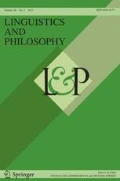Abstract
Radical contextualists have observed that the content of what is said by the utterance of a sentence is shaped in far-reaching ways by the context of utterance. And they have argued that the ways in which the content of what is said is shaped by context cannot be explained by semantic theory. A striking number of the examples that radical contextualists use to support their view involve sentences containing color adjectives (“red”, “green”, etc.). In this paper, I show how the most sophisticated analysis of color adjectives within the explanatory framework of compositional truth conditional semantics—recently developed by Kennedy and McNally (Synthese 174(1):79–98 2010)—needs to be modified to handle the full range of contextual variation displayed by color adjectives.
Similar content being viewed by others
References
Albers J. (2006) Interaction of color. Yale University Press, New Haven
Austin J.L. (1962) Sense and sensibilia. Oxford University Press, Oxford
Bach K. (2002) Seemingly semantic intuitions. In: Campbell J.K., O’Rourke M., Shier D. (eds) Meaning and truth.. Seven Bridges Press, New York
Barker C. (2002) The dynamics of vagueness. Linguistics and Philosophy 25(1): 1–36
Bezuidenhout A. (2002) Truth conditional pragmatics. Noûs 36(16): 105–134
Brogaard B. (2009) Perspectival truth and color perception. In: Wright C., Pedersen N. (eds) New waves in truth. Palgrave MacMillan, New York
Cappelen H., Lepore E. (2005) Insensitive semantics: A defense of semantic minimalism and speechact pluralism. Blackwell, Oxford
Chomsky N. (2000) Language and interpretation. In New horizons in the study of language and mind. MIT Press, Cambridge, MA
Cohen J. (2004) Color properties and color ascriptions: A relationalist manifesto. The Philosophical Review 113(4): 451–506
Crary A. (2007) Beyond moral judgment. Harvard University Press., Cambridge, MA
Evans R. (1948) An introduction to color. Wiley, New York
Evans R. (1974) The perception of color. Wiley, New York
Fodor J. (2003) Hume variations. Oxford University Press, Oxford
Glanzberg M. (2007) Context, content, and relativism. Philosophical Studies 136(1): 1–29
Hardin C.L. (1983) Colors, normal observers, and standard conditions. The Journal of Philosophy 80(12): 806–813
Hardin C.L. (1988) Color for philosophers: Unweaving the rainbow. Hackett, Indianapolis
Jameso D., Hurvich L.M. (1975) From contrast to assimilation: In art and in the rye. Leonardo 8(2): 125–131
Kennedy C. (1999) Projecting the adjective: The syntax and semantics of gradability and comparison. Garland Publishing, Inc., New York
Kennedy C. (2007) Vagueness and grammar: The semantics of relative and absolute gradable adjectives. Linguistics and Philosophy 30(1): 1–45
Kennedy C., McNally L. (2005) Scale structure and the semantic typology of gradable predicates. Language 81(2): 345–381
Kennedy C., McNally L. (2010) Color, context, and compositionality. Synthese 174(1): 79–98
Klein E. (1980) A semantics for positive and comparative adjectives. Linguistics and Philosophy 4(1): 1–45
Lasersohn P. (2005) Context dependence, disagreement and predicates of personal taste. Linguistics and Philosophy 28(6): 643–686
MacFarlane J. (2007) Semantic minimalism and nonindexical contextualism. In: Preyer G., Peter G. (eds) Context-sensitivity and semantic minimalism: New essays on semantics and pragmatics. Oxford University Press, Oxford
MacFarlane J. (2009) Nonindexical contextualism. Synthese 166(2): 231–250
Moltmann F. (2005) Part structures in situations: The semantics of individual and whole. Linguistics and Philosophy 28(5): 599–641
Noë A. (2004) Action in perception. MIT Press, Cambridge, MA
Predelli S. (2005) Painted leaves, context, and semantic analysis. Linguistics and Philosophy 28(3): 351–374
Recanati F. (2004) Literal meaning. Cambridge University Press, Cambridge, MA
Rothschild D., Segal G. (2009) Indexical predicates. Mind & Language 24(4): 467–493
Ruskin J. (1876) The elements of drawing. Wiley, New York
Sainsbury R.M. (2001) Two ways to smoke a cigarette. Ratio 14(44): 386–406
Searle J.R. (1978) Literal meaning. Erkenntnis 13(1): 207–224
Stephenson T. (2007) Judge dependence, epistemic modals and predicates of personal taste. Linguistics and Philosophy 30(4): 487–525
Stojanovic I. (2007) Talking about taste: Disagreement, implicit arguments and relative truth. Linguistics and Philosophy 30(6): 691–706
Sundell T. (2010) Disagreements about taste. Philosophical Studies 155(2): 267–288
Szabó Z.G. (2000) Problems of compositionality. Garland Publishing, Inc., New York
Szabó Z.G. (2001) Adjectives in context. In: Kenesei I., Harnish R.M. (eds) Perspectives on semantics, pragmatics, and discourse. John Benjamins, Amsterdam
Travis C. (1975) Saying and understanding: A generative theory of illocutions. Blackwell, Oxford
Travis C. (1981) The true and the false: The domain of the pragmatic. John Benjamins, Amsterdam
Travis C. (1985a) On what is strictly speaking true. Canadian Journal of Philosophy 15(2): 345–366
Travis C. (1985b) Vagueness, observation, and sorites. Mind 94(375): 345–366
Travis C. (1989) The uses of sense: Wittgenstein’s philosophy of language. Oxford University Press, Oxford
Travis C. (1994) On constraints of generality. Proceedings of the Aristotelian Society 94: 165–188
Travis C. (1997) Pragmatics. In: Hale B., Wright C. (eds) A companion to the philosophy of language. Blackwell, Oxford
Travis C. (2000) Unshadowed thought. Harvard University Press, Cambridge, MA
Travis C. (2006) Thought’s footing. Oxford University Press, Oxford
Wilson M. (2006) Wandering significance. Oxford University Press, Oxford
Wittgenstein L. (1967) Zettel. Basil Blackwell, Oxford
Author information
Authors and Affiliations
Corresponding author
Rights and permissions
About this article
Cite this article
Hansen, N. Color adjectives and radical contextualism. Linguist and Philos 34, 201–221 (2011). https://doi.org/10.1007/s10988-011-9099-0
Published:
Issue Date:
DOI: https://doi.org/10.1007/s10988-011-9099-0




